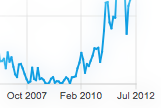- class QDateTimeAxis#
The
QDateTimeAxisclass adds dates and times to a chart’s axis. More…Synopsis#
Properties#
formatᅟ- String that is used when creating the label for the axis out of a QDateTime objectmaxᅟ- Maximum value on the axisminᅟ- Minimum value on the axistickCountᅟ- Number of tick marks on the axis
Methods#
def
__init__()def
format()def
max()def
min()def
setFormat()def
setMax()def
setMin()def
setRange()def
setTickCount()def
tickCount()
Signals#
def
formatChanged()def
maxChanged()def
minChanged()def
rangeChanged()
Note
This documentation may contain snippets that were automatically translated from C++ to Python. We always welcome contributions to the snippet translation. If you see an issue with the translation, you can also let us know by creating a ticket on https:/bugreports.qt.io/projects/PYSIDE
Detailed Description#
QDateTimeAxiscan be set up to show an axis line with tick marks, grid lines, and shades. The labels can be configured by setting an appropriate DateTime format.QDateTimeAxisworks correctly with dates from 4714 BCE to 287396 CE. For other limitiations related to QDateTime, see QDateTime documentation.QDateTimeAxiscan be used with anyQXYSeries. To add a data point to the series, QDateTime::toMSecsSinceEpoch() is used:QLineSeries *series = new QLineSeries; QDateTime xValue; xValue.setDate(QDate(2012, 1 , 18)); xValue.setTime(QTime(9, 34)); qreal yValue = 12; series->append(xValue.toMSecsSinceEpoch(), yValue); xValue.setDate(QDate(2013, 5 , 11)); xValue.setTime(QTime(11, 14)); qreal yValue = 22; series->append(xValue.toMSecsSinceEpoch(), yValue);
The following code snippet illustrates adding the series to the chart and setting up
QDateTimeAxis:QChartView *chartView = new QChartView; chartView->chart()->addSeries(series); // ... QDateTimeAxis *axisX = new QDateTimeAxis; axisX->setFormat("dd-MM-yyyy h:mm"); chartView->chart()->setAxisX(axisX, series);
Note
Properties can be used directly when
from __feature__ import true_propertyis used or via accessor functions otherwise.- property formatᅟ: str#
This property holds The format string that is used when creating the label for the axis out of a QDateTime object..
See QDateTime documentation for information on how the string should be defined.
See also
- Access functions:
Signal
formatChanged()
This property holds The maximum value on the axis..
When setting this property, the minimum value is adjusted if necessary, to ensure that the range remains valid.
- Access functions:
Signal
maxChanged()
This property holds The minimum value on the axis..
When setting this property, the maximum value is adjusted if necessary, to ensure that the range remains valid.
- Access functions:
Signal
minChanged()
- property tickCountᅟ: int#
This property holds The number of tick marks on the axis..
- Access functions:
Constructs an axis object that is a child of
parent.- format()#
- Return type:
str
See also
Getter of property
formatᅟ.- formatChanged(format)#
- Parameters:
format – str
This signal is emitted when the
formatof the axis changes.Notification signal of property
formatᅟ.Getter of property
maxᅟ.This signal is emitted when the maximum value of the axis, specified by
max, changes.Notification signal of property
maxᅟ.Getter of property
minᅟ.This signal is emitted when the minimum value of the axis, specified by
min, changes.Notification signal of property
minᅟ.This signal is emitted when the minimum or maximum value of the axis, specified by
minandmax, changes.Setter of property
formatᅟ.Setter of property
maxᅟ.Setter of property
minᅟ.Sets the range on the axis from
mintomax. Ifminis greater thanmax, this function returns without making any changes.- setTickCount(count)#
- Parameters:
count – int
Sets the number of tick marks on the axis to
count.See also
Setter of property
tickCountᅟ.- tickCount()#
- Return type:
int
Returns the number of tick marks on the axis.
See also
Getter of property
tickCountᅟ.- tickCountChanged(tick)#
- Parameters:
tick – int
This signal is emitted when the number of tick marks on the axis, specified by
tickCount, changes.Notification signal of property
tickCountᅟ.
